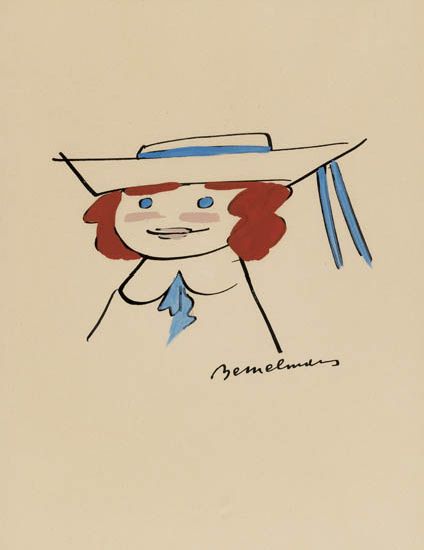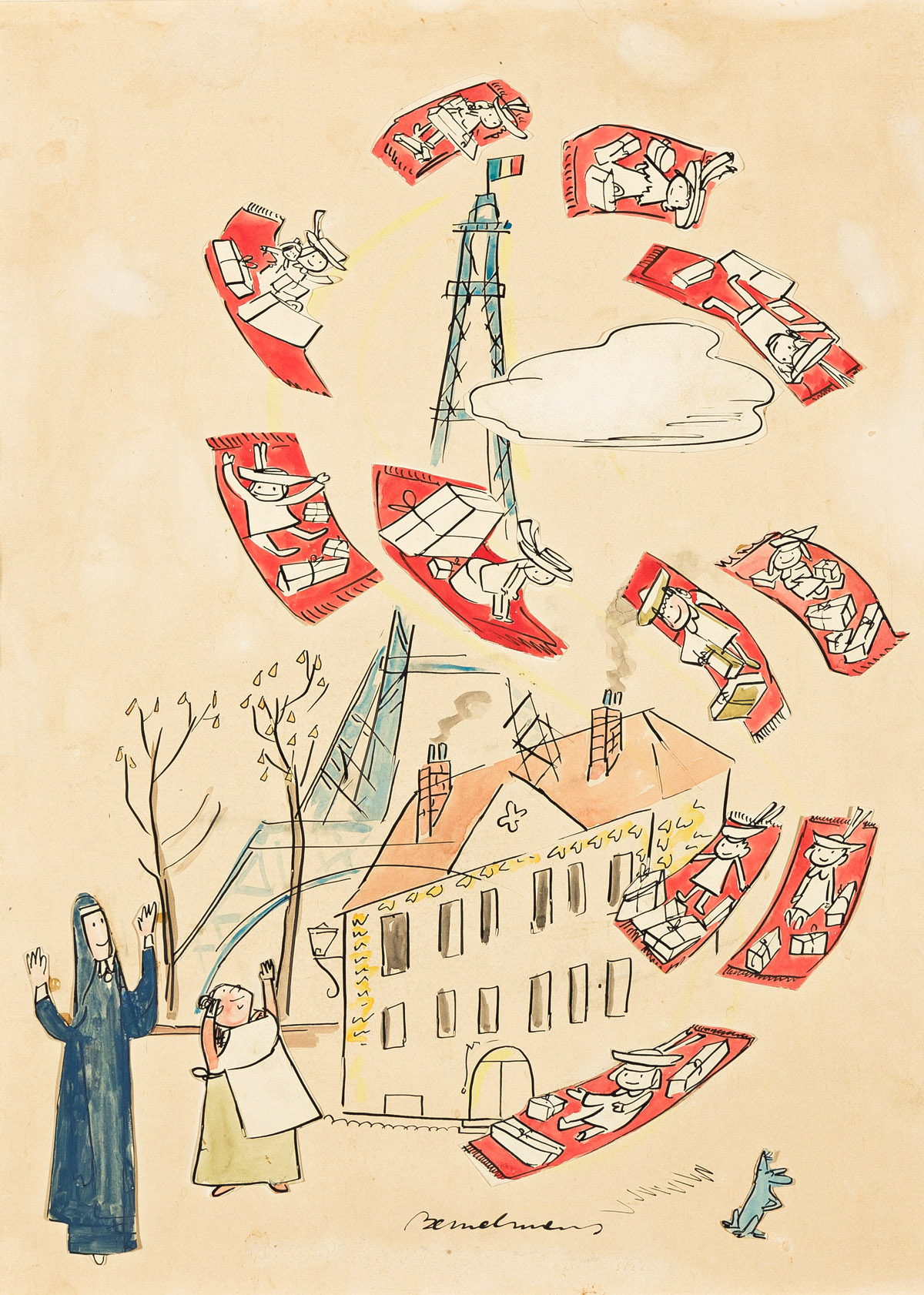Artist Profile: Georges Lepape
Georges Lepape: Patriotism & Sentimentality in World War I Era Women’s Magazines
World War I invaded every aspect of public life, including illustrated magazines of the period. While some women’s magazines, like the Gazette du Bon Ton, temporarily ceased publication during the war years, others continued to offer the pleasantries and frivolities of fashion, jewelry, and beauty while simultaneously acknowledging the social landscape of war, specifically the disruption it brought to the lives of their female readership. Georges Lepape is one of the many French artists who responded to the horrors of war through imagery. Lepape, who had an established reputation as a high-style fashion illustrator by this point, produced patriotic and sentimental illustrations that blended the realms of luxury and high fashion with women’s wartime experiences on the home front.
Georges Lepape
Lepape made a name for himself in 1911 when he illustrated Paul Poiret’s designs in Les Choses, whose success brought him commissions for the covers of magazines in Paris and London, and couture designs for leading fashion houses. La Gazette du Bon Ton, an influential fashion and luxury publication targeting women of the French elite, was particularly suited to Lepape’s intricate style. The high-quality paper enhanced the dazzling beauty of the publication’s vividly colored pochoir fashion plates and added another layer of lavish opulence to the sumptuous couture depicted. Lepape was a primary contributor to the publication, along with other leading Art Deco artists and illustrators of the day, such as George Barbier and André Édouard Marty.

An illustration (above) by Marty published in the July 1914 issue of La Gazette du Bon Ton documents a party in celebration of the publication hosted by Paul Poiret at his famed Hôtel d’Antin. Couturiers, artists, and contributing writers attended the soiree, which included dinner in the elegant garden strung with garlands of lights, a dance performance, and an elaborate fireworks display. The party, held in June 1914, captures an evening of extravagance for the French elite, whose lives would soon be disrupted with the start of World War I the following month.
Outbreak of World War I
The war began just as Lepape was reaching the pinnacle of his profession. Suffering from arthritis, Lepape was exempt from service. (He briefly enlisted only to return home shortly after due to medical issues).1
At the start of the conflict, much of the French population believed it would be settled quickly. However, as the months dragged on, every segment of society began to feel the war’s totalizing impact as the French government nurtured the loyalty of its civilians, often through dramatic appeals of patriotism.
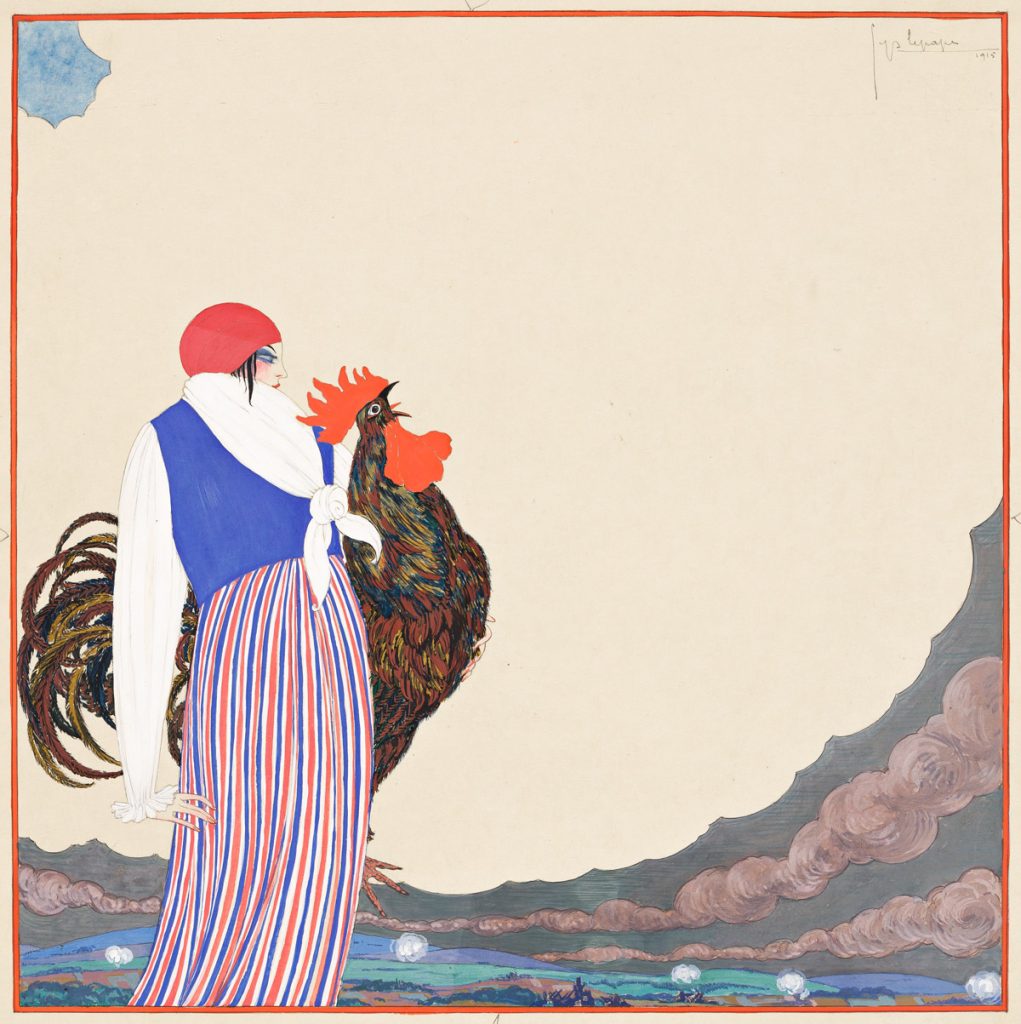
Patriotic imagery flooded the media, and the fashion and beauty industries were no exception. Lepape drew upon Revolution-era imagery for his illustrated advertisements for “Mam’zelle Victoire,” a perfume by Rosine, a branch of the house of Paul Poiret.
The illustration prominently features a rooster, a longtime French emblem representing courage and bravery, which was mobilized as a symbol of the people and the state during the French Revolution. Bedecked in red, white, and blue, the woman wears a red cap, which resembles both the Phrygian liberty cap of the earlier era, as well as reflects the fashionable contemporary turbans popularized by Poiret. Art Deco designers of the period were heavily influenced by a 1910 performance of Scheherazade by the Ballets Russes, which sparked a mania for Orientalism. This is reflected in both the fashion and Lepape’s overall style, where the intricate landscape and the woman’s exoticized features show the influence of Persian miniatures.
Women and War
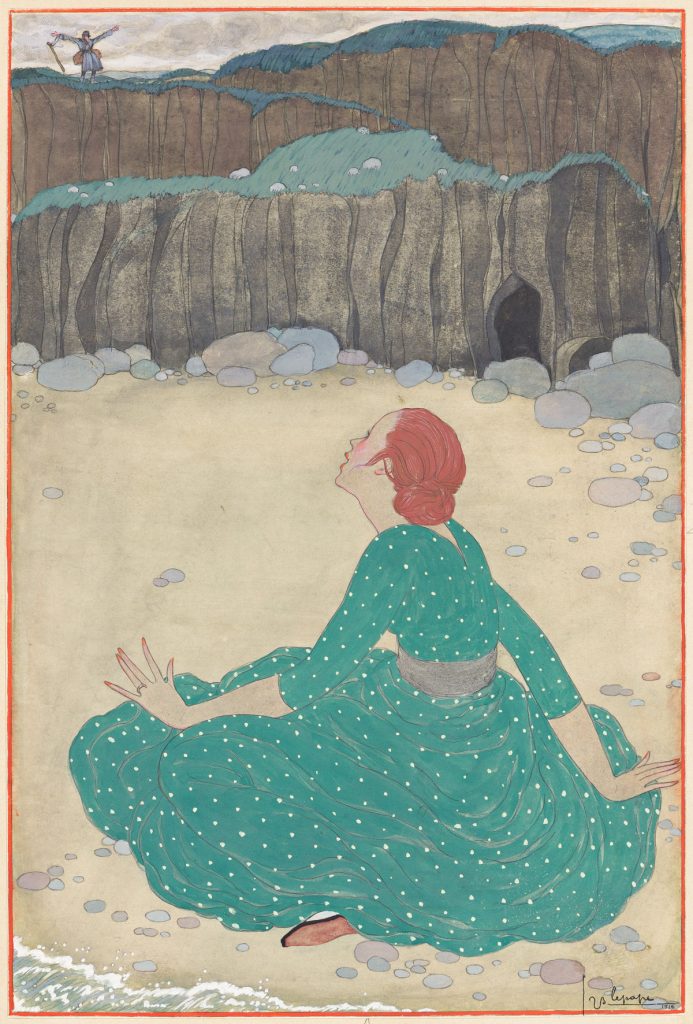
Lepape continued to illustrate throughout the war years and his artwork for women’s magazines reflects the themes of both hardship and duty felt by their readership.
Le Retour, a 1916 illustration for an unknown publication, captures a moment where a woman who is seated at the seashore and longingly awaits the return of her husband first glimpses her beloved soldier, who gestures to her from the nearby cliffs. Exquisitely dressed in a green polka dot gown, her prominently displayed hand with its gold wedding band highlights her status as a young wife.
The scene reflects Lepape’s skill for narrative imagery, as his fashion illustrations routinely place the viewer at a pivotal point of action in a scene. In contrast to the comparably static fashion plates of the previous century, his models are often pictured in motion, leaving the frame, or turning their backs to the viewer.
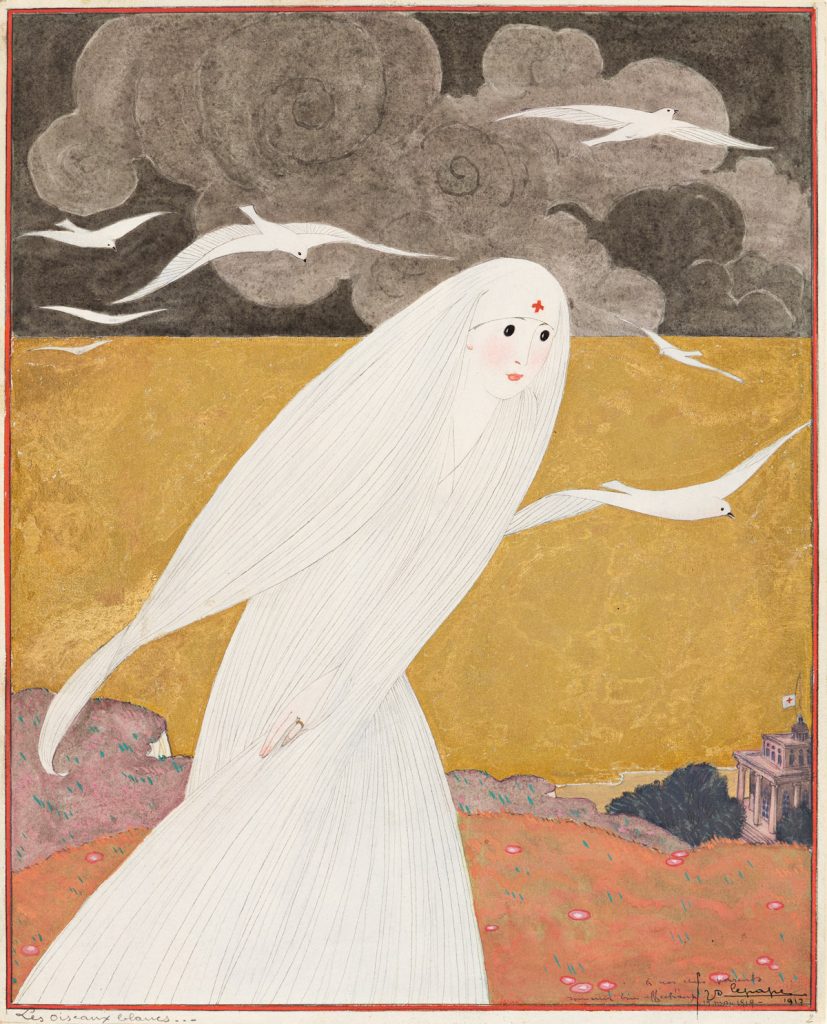
Les Oiseaux Blancs, a version of a cover for Femina’s quarterly war issue in June 1917, reflects a different and less sentimental experience that would also be very relatable to the magazine’s bourgeois female readership. A woman takes active participation in the war effort by heralding the call of duty to work as a nurse. Far from the helpless woman waiting cliffside in the earlier image, the nurse walks the cliffs with confidence and purpose as white doves soar around her against a dark and turbulent sky. This illustration is more hopeful, reflecting a longing for peace in turbulent times. It also exudes elegance and opulence in its sparkling metallic gold background, which Lepape also uses to draw attention to the wedding band, the presence of which highlights the absence of her husband, who is presumably away at the front. It must have held exceptional meaning for Lepape, as he inscribed it to his parents in May 1919.
Victory
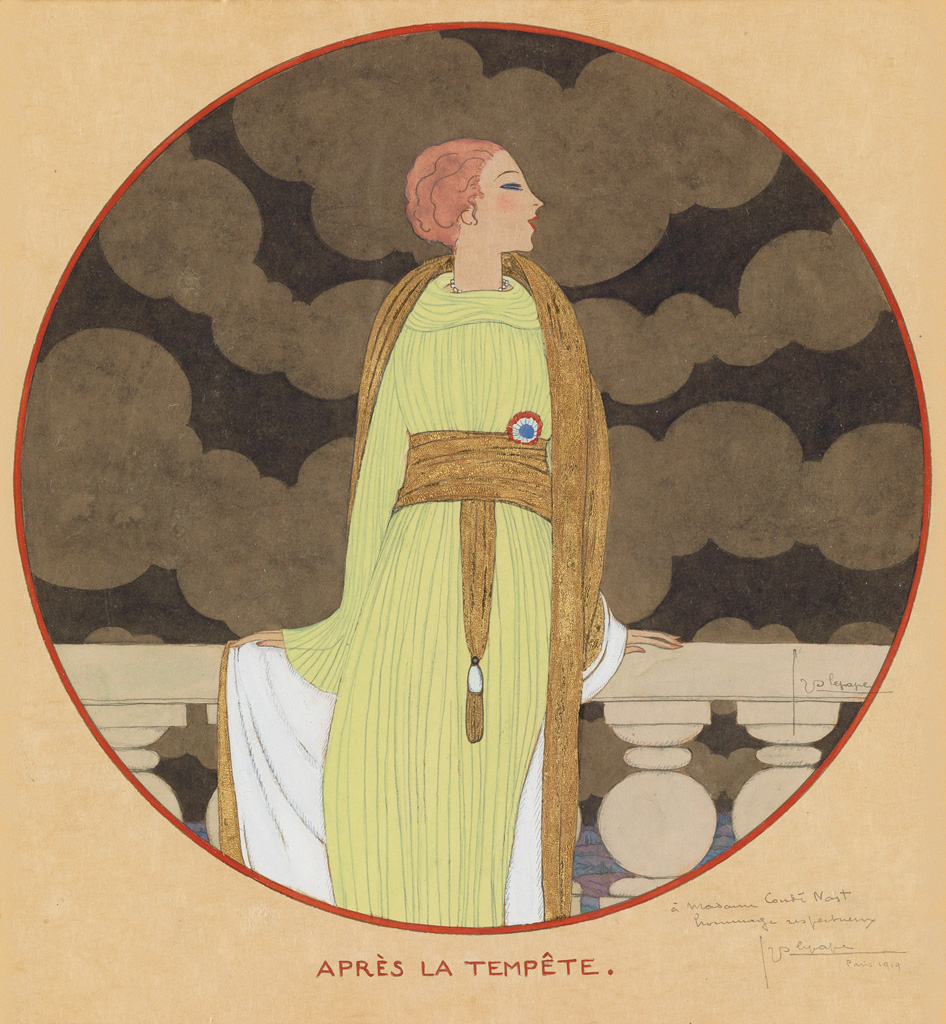
After four years of combat and more than 8 million deaths, the Allies declared victory on November 11, 1918. France was left victorious but irrevocably scarred. Lepape, who created his first cover for Vogue in 1916, produced Après la Tempête for the publication’s April 1919 cover. Featuring Clarisse Coudert, then wife of Vogue’s publisher Condé Montrose Nast, standing before a stormy sky in a classic Fortuny tea gown with gold robe and a Bleuet de France pinned to the bodice, the cover reflects France’s atmosphere at the end of the war.
By 1926, Lepape had moved to New York City where he solidified a long and profitable relationship with Vogue. He continued to be highly sought-after by leading publications and received commissions for luxury brands, as well as costume and set designs, until his death in 1971.
- Claude Lepape and Thierry Defert. Georges Lepape ou l’Élégance Illustrée. Paris: Hersche, 1983, page 81.
Do you have an original work by Georges Lepape we should take a look at?
Learn about how to consign to an auction, and send us a note about your item.
